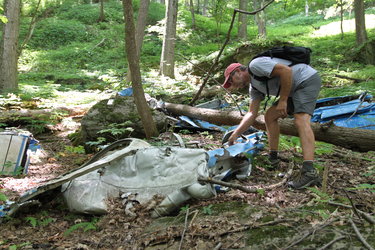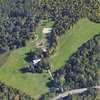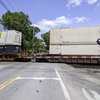Piecing together a local pilot’s life and sudden death
VOORHEESVILLE — Dale Boyd Knox of Delmar was 38, a husband and father, fire-district commissioner, military veteran, and small-business owner. He died 47 years ago when the single-engine plane he was piloting crashed into a cliff on the Helderberg escarpment in New Scotland near Thacher Park.
He was alone in his four-seater Beechcraft BE35 V-tail Bonanza at the time of his crash on April 12, 1972.
The plane’s remains still lie in the deep woods off Picard Road, and his family is still haunted by the mystery surrounding his death.
Dale Knox’s older brother, Alan Knox, remembers him as “one of the most fun-loving and hardest-working people around” and as “an all-around guy.”
“There’s a French phrase, joie de vivre,” Alan Knox said. “If ever there was somebody who enjoyed life, it was Dale.”
Dale grew up on Font Grove Road in Slingerlands, one of three sons of Milton and Dorothy Knox. Alan and Dale were close in age; many years later, a third brother, Robin, came along.
The boys’ father, Milton Knox, was an attorney at a civil practice in the city of Albany, while their mother, Dorothy Knox, had a staff position as the director of volunteers for the Albany Medical Center Hospital, Alan Knox said.
Their father was an avid tennis player, and the family had a clay court at their home. It was there that Dale Knox honed his love for and prowess at tennis, his brother recalled. Dale was captain of the tennis team at Bethlehem Central High School, Alan Knox said, and continued to play at a high level while in the Air Force.
Dale Knox served in the military from 1952 through 1956, according to the United States Department of Veterans Affairs online records. One of his duties was to serve as a flight mechanic, his brother said, fixing planes that were on the ground or even in the air.
He was stationed in the Mediterranean and the Middle East and did not see any combat during his service, his brother said. He played on the Air Force tennis team, hopping on as a passenger on an Air Force plane to make it to the next scheduled match at a United States military installation — for instance, traveling from Tripoli in Libya to Germany for a match.
Dale Knox headed the Knox Construction Company, building and renovating houses. He had built it up from a small company, his brother said, and was good at getting to know many people in town, which was important for his business.
He married Laura Jane Brown, and the couple raised two children in their home at 74 Adams Place.
Dale Knox was for many years a volunteer firefighter and had served as fire-district commissioner. He enjoyed being active in his community, his brother said.
Dale Knox had been one of the firefighters on the scene when a plane crashed into the parking lot of the Delmar Town Hall in 1968, according to a photograph and a news story on the wall of the firehouse on Adams Street. In that earlier crash, all three people on board survived.
Dale Knox got his own airplane, his brother said, in part because he was beginning to get more business in a larger region. Flying brought together the different parts of his life — his experience in the military and his work as a builder, Alan Knox said.
A one-paragraph mention of his crash in the Coeymans News-Herald of April 21, 1972 noted that flags in the Delmar fire district were flying at half-mast to “show respect and honor to their brother fireman.”
His wife followed him in death soon afterward; the couple’s gravestone lists her year of death as 1977.
Alan Knox’s son, Brian Boyd Knox, who was born in 1956 and who shares his pilot uncle’s middle name, said, “He had two children and a construction company, and things seemed to be going well. Nobody quite understands what happened.”
Brian Knox described his uncle as a ”pretty gregarious guy” with a good sense of humor. The family refers to it as “Knox humor,” Brian Knox said, explaining, “My grandfather was a bit of a jokester, and we all have enjoyed puns and family jokes, it sort of runs in the family.”
Dale Knox was “definitely a family man, fun to talk to,” his nephew said. He continued, describing his uncle as a “tall, good-looking guy, sort of a stand-out-in-the-crowd sort of guy, probably the most handsome of the three boys.”
Alan Knox said of his brother’s crash, “It remains forever a mystery. I know lots of information about before, during, or after that event. I was not a co-pilot, I was not in the plane, I don’t know what happened in those few seconds in the plane. And that continues to be a matter of speculation.”
For Alan Knox, who is 90, those few seconds are also a matter of lifelong regret. He and his brother were just two years and two months apart and were “probably best friends,” he said. There were not many kids around their home on Font Grove Road, he said, and he and Dale Knox were constant companions, exploring the woods and streams all around the area, digging caves and building huts.
“I really regret those few seconds, because it ended that abruptly,” he said, and left him and the rest of the family to live with that mystery.
The crash
Accounts of Dale Knox’s crash — which was not covered by The Enterprise — vary greatly in their details.
David Albright, who grew up in New Scotland and now lives in Endicott in Broome County, told The Enterprise that he and a friend “saw the whole thing go down.” Several newspaper accounts from the time mention two boys who witnessed the crash and who gave their accounts to police.
Albright told The Enterprise that he was 8 and riding on his yellow banana-seat bike when he and his friend saw a plane flying very low — just 300 to 500 feet off the ground — and stopped to stare at it. The pilot saw them too, Albright said, and waved. Albright described it, all these years later, as “like he was saying one last goodbye.”
After waving, Albright said, the pilot “does a circle over the top of me and then boom, into the cliff.”
The full circle, parallel to the ground, Albright said, had brought the plane back into its original direction, heading straight for the cliff, and specifically for a vertical crevice that was the one dark spot in the otherwise relatively smooth face of the escarpment.
Albright said that, as a child, he knew little about suicide, but looking back now he believes the pilot was “saying his farewells and going headlong into hopefully another life.”
The accident report by the National Transportation Safety Board on the April 12, 1972 crash, was provided to The Enterprise by Chris Albright of New Scotland, a retired air-traffic controller, who is David Albright’s brother. The report states that an observer saw Knox’s single-engine plane flying low next to the cliff and then pull steeply up to the left, into the cliff.
Knox had set out in his Beechcraft Bonanza C35 from Albany Airport on April 12, 1972, on a noncommercial trip, without filing a flight report, the report says, and he had “exercised poor judgment” and “misjudged clearance.”
Pilots heading out on a short trip might very well not file a flight plan, said Chris Albright.
The scene
The body of Dale Knox does not rest in the woods with his plane. He is buried in the Bethlehem Cemetery on Kenwood Avenue in Delmar.
There are no trails to the plane, which is surrounded by maple, oak, beech, and shag-bark hickory trees.
During a recent steep hike there, a family of ruffed grouse were startled by the arrival of people, and flew off, the chicks scurrying in one direction and the mother flying in the other.
“She was probably trying to draw us away from her babies,” Chris Albright said.
According to an account in the Lockport Union-Sun and Journal on April 13, 1972, Knox’s craft “plunged into the side of a cliff, then down into a deep crevice” near Thacher Park.
Sheriff’s deputies on patrol in the area said they saw the craft disappear and notified the state police, according to this account, which adds that the plane “slammed directly into a ledge about 500 feet from the top of a cliff.”
According to the Lockport Union-Sun and Journal, “state police had to use ropes to scale the cliff and were hampered by snow and ice under dead leaves in the park.”
The broken remains of the airplane now lie in woods below the cliff.
According to a story that ran in the Times Record of Troy on April 13, 1972, state police of Selkirk said the plane became wedged in a crevice about 300 feet from the summit of the 1,600-foot ledge, with its nose and passenger compartment buried in the crevice.
Rescue workers used ropes and battled icy conditions to reach the plane, the TImes Record said. When they reached the level of the aircraft, they had to pull the plane from the crevice, which took almost three hours, according to the Times Record; it was only after this that they could recover Knox’s body.
No rescuers were injured, the Times Record said.
Chris Albright, the retired air-traffic controller, theorizes that, when first responders managed to pull the craft from the cliff, the force of the necessary effort caused it to fall. The engine and nose gear are about 30 feet below the base of the vertical rock of the cliff, and the remainder of the plane another few hundred feet below that.
“I don’t think he misjudged the clearance,” Chris Albright said, citing his brother’s account. “He was in level flight, and it doesn’t look like he made an effort to try to avoid hitting the cliff, from what I’ve heard.”
His brother, David Albright, has wondered about it many times over the years since watching the crash as a boy. Was the pilot really aiming for the crevice? “I would have thought — If I were trying to commit suicide, I would have hit a nice flat spot, you know what I mean?” he said this week. “He hit the one dark spot where it goes into the cliff.”
David Albright added, “I don’t remember his path wavering at all. Doesn’t mean it didn’t happen.”
Another local retired air-traffic controller, Jon Gray — who had lived in Delmar, had been friendly with Dale Knox’s son in school, and had visited the family’s camp on Helderberg Lake once with mutual friends a couple of years after Dale Knox’s death — speculated that perhaps what Dale Knox had intended was not suicide, but to fly close to his own camp, in greeting.
“It would have been a natural thing to do, to buzz his camp,” said Gray.
Dale Knox’s brother, Alan, offers another theory. Maybe Dale Knox was heading for the airport at New Salem, and was unable at the last minute to pull up to avoid the cliff, perhaps because of a wind tunnel that formed in the crevice and drew him in.



